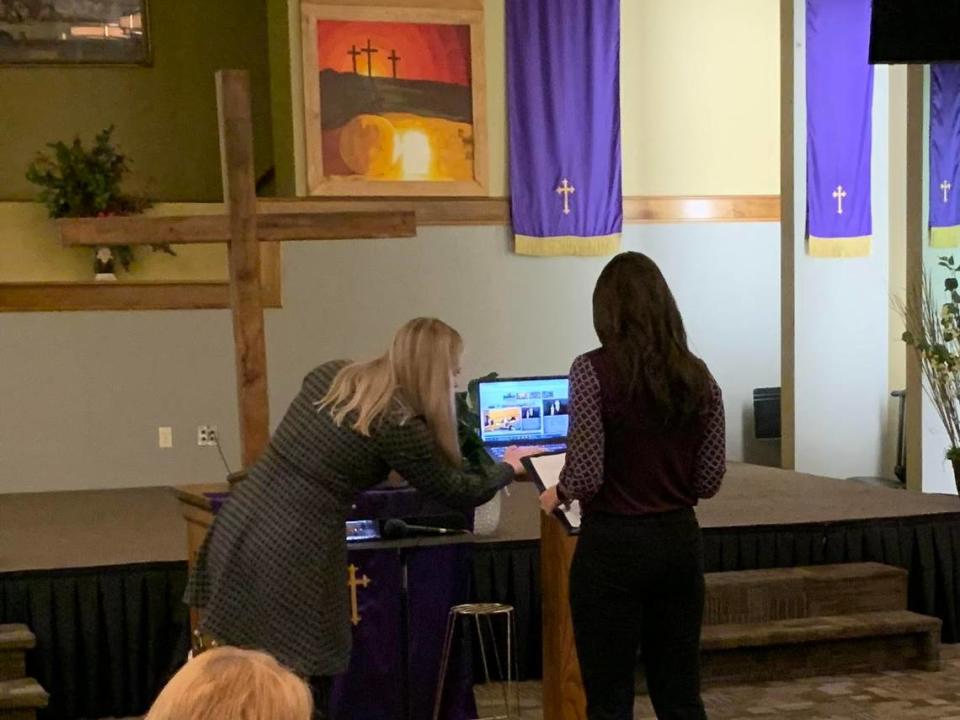Fate of Kansas’s 3rd Congressional District is uncertain. But some see a clear solution
As Kansas lawmakers prepare to draw new congressional maps, the question looming over the process has been the fate of the 3rd district. Too many people live within its current boundaries.
Among 3rd district residents paying the closest attention and speaking publicly, the solution is clear.
In town halls held in August and again this week, broad agreement has emerged that the 3rd — currently comprising all of Wyandotte and Johnson counties and part of Miami County — should be trimmed by shifting portions of southern and western Johnson into the 2nd district.
At least some leaders from those areas, however, sound ambivalent.
Democrats and some 3rd district residents fear Republicans will split Wyandotte County or place it in another district. They point to past scenarios, such as a 2012 proposal to put the urban county in the 1st district, which covers the state’s rural western areas.
Moving portions of Johnson County, however, would keep the district’s metro core together and avoid cutting up Wyandotte, a Democratic stronghold and the state’s most racially and ethnically diverse county. And the exurban and rural communities in Johnson County that would swap districts would likely feel more at home in the Republican-leaning 2nd, proponents say.
“These areas are more rural and may have more in common with residents in the Second District,” Michael Miller, a Roeland Park resident, said in written testimony to a redistricting town hall on Tuesday.
Spring Hill, Gardner, Edgerton, De Soto, Stilwell and other small cities and townships in outlying Johnson County would be the most likely to move under this scenario, along with the northern part of Miami County currently in the 3rd.
At stake potentially is which party will represent these communities in Congress over the next decade. The 2nd has been under Republican control since 2009, while the 3rd, currently represented by Democrat Sharice Davids, switched parties in the 2018 election.
The GOP-controlled Legislature must either approve new maps that can win the signature of Democratic Gov. Laura Kelly or override her veto next spring. If lawmakers fail, federal judges will almost certainly intervene and impose their own maps in time to allow fall elections to proceed.
Wyandotte and Johnson counties together are roughly 44,000 residents above the legally required district size of 734,470 — one-fourth of the Kansas population. Michael Smith, a political scientist at Emporia State University who studies redistricting, has found that moving several of these smaller Johnson County cities would remove enough residents to keep the rest of the district together.
Amy Carter, an Overland Park resident, said areas west of De Soto and south of 175th Street could be excluded from the 3rd District if necessary.
“Those areas are generally more rural than the closer suburbs of Kansas City,” Carter said at a town hall Tuesday.
Mike Taylor, a former lobbyist for the Unified Government of Wyandotte County and Kansas City, Kansas, said Johnson County’s northeastern communities in particular have a close connection to Wyandotte — as opposed to Johnson’s western and southern edges.
“I think it makes a lot of sense to say cities like Gardner, Spring Hill, De Soto and, of course, the Miami County piece, probably shift down into the 2nd district,” Taylor said.
But the idea is drawing mixed reaction from some community leaders. De Soto Mayor Rick Walker said moving the city into the 2nd isn’t his first choice. Ideally, he believes Johnson County should retain a single representative.
“My personal perspective, it would be important that the county have one voice, one representative because we have common interests,” Walker said.
Still, Walker acknowledged that discussions appear headed toward splitting off parts of Johnson County.
“It seems like, from our perspective, we’re forgotten that we’re even a part of the county,” he said.
On the other hand, Rep. William Sutton, a Gardner Republican, recently told The Star he would have no issue if his area moved into the 2nd district.
“I’m not getting heartburn off of that. Absolutely not,” he said.
Sen. Molly Baumgardner, a Louisburg Republican, said it’s most important to ensure individuals are truly represented, though she acknowledged slicing across southern Johnson County would result in divisions.
“It is going to divide communities and that’s been a problem because Paola is in the 2nd whereas Louisburg is in the 3rd and that’s one of the goals to not divide up communities,” Baumgardner said.
Lawmakers have yet to officially propose any maps. Republicans leading the redistricting effort have stayed silent on their plans, saying they are waiting to put forward proposals until the House and Senate redistricting committees begin crafting districts in January.
Tuesday marked the end of the Legislature’s town hall-style listening sessions. After a series of in-person town halls in August were criticized for taking place before the release of detailed Census population data, the committees held another round in November.
The latest gatherings combined virtual and in-person testimony. Committee members tuned in online to hear from members of the public who traveled to sites set up for in-person testimony, in addition to those who spoke virtually.
The hybrid arrangement created a few awkward moments.
During the final town hall Tuesday evening, about a dozen people who showed up to a site in Stilwell had only a single laptop to watch. When it came time to provide testimony, speakers stood in front of the laptop, which sat on a lectern in front of a giant cross inside a church sanctuary.

Another site, at Bonner Springs city hall, had larger screens but the main entrance to the building was locked, temporarily stranding a member of the public and a reporter outside.
“My basic thought was we just need to have bodies in the room, but now my body’s not in the room,” said Christina Miller, a Mission Hills Democrat concerned about gerrymandering.
Both Miller and the reporter eventually found an unlocked door.

 Yahoo Movies
Yahoo Movies 
